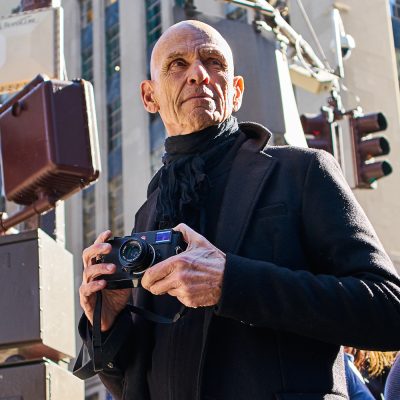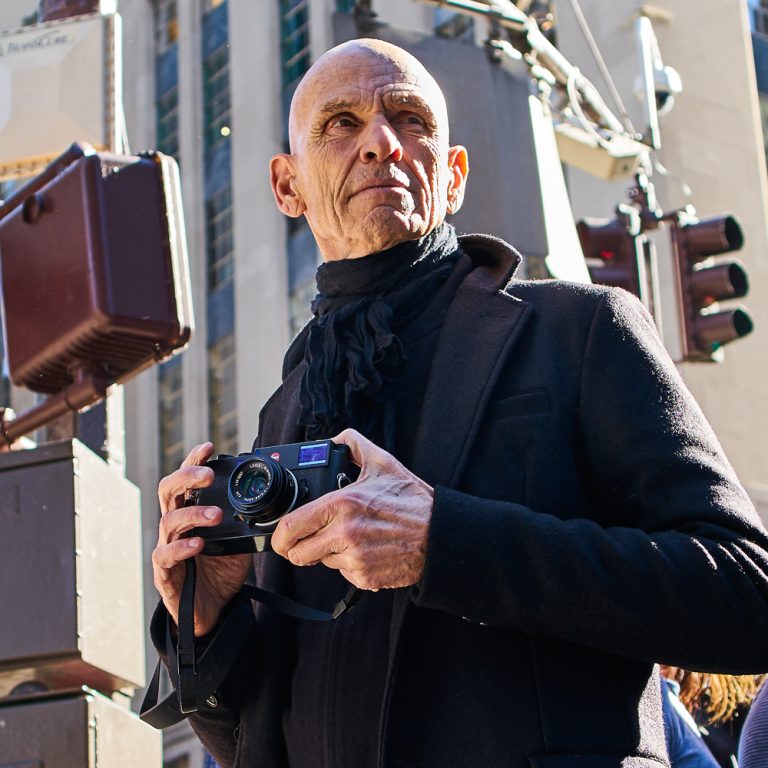Welcome!
Most photographers wander for years, unsure of how to truly grow their craft. I’ve been there. After years of experimenting, failing, and learning, I realized something:
Growth happens when you follow a path, not just chase random tips.
So instead of just sharing theory, I want to give you something more valuable, a practical roadmap.
This is the exact process I believe every photographer should follow to master their skill and grow with intention.
Table of Contents
Lesson #01 - Find Your Master

Every photographer has that one mentor… Someone whose work and vision spark something deep inside. For me, that’s Joel Meyerowitz.
Why Joel?
There’s something magical about Joel. The way he sees the world through his lens, and the way he teaches photography, feels incredibly personal and real — like he’s photographing life itself.
His lessons go beyond technique. It’s about feeling the moment, telling stories, and finding beauty in the everyday.
How I Found His Masterclass
When I discovered Joel’s masterclass, I didn’t just want to watch but I wanted to be part of that world.
So I reached out to Chris Ryan, the founder of Masters of Photography, and asked if I could join the class and dive deep into Joel’s work.
Chris has an amazing gift for curating some of the most talented photographers in the world. His platform offers inspiring, in-depth courses that truly motivate creatives like us.
Why I Chose Joel
While there are many incredible instructors on the platform, I wanted to focus on just one — Joel Meyerowitz.
He quickly became my favorite because of how he captures:
- Street life with unmatched storytelling
- Light in a way that feels poetic
- Color with intentional emotion
- And yes, his quiet, thoughtful landscapes from Cape Cod
How He Changed My Photography
Joel’s work opened my eyes. It changed how I see the world, how I approach photography, and how I tell stories through a frame.
Now, I want to share those lessons with you — through my own process, practical insights, and creative experiments inspired by Joel himself.
Joel Meyerowitz’s photography is a masterclass in seeing the world differently. Over decades, he’s captured moments that tell stories, whether it’s the vibrant chaos of city streets or the quiet beauty of nature.
Some of his most admired work includes:
Street Photography in New York City: Joel was one of the pioneers to shoot street photography in color, capturing raw, unfiltered life with striking emotion and depth.
Cape Cod Landscapes: His serene, painterly landscapes at Cape Cod reveal a quieter side of his vision, intimate, thoughtful, and breathtaking.
The Aftermath of 9/11: Joel was among the first photographers granted access to Ground Zero, creating a powerful and respectful visual record of this historic moment.
These projects showcase not only his technical mastery but also his unique ability to tell stories that resonate deeply.
Some links on this website are affiliate links which means we may earn a small commission – at no extra cost to you. Learn how it works.
Lesson #03 - Buy a Camera that Inspires You
Let’s be real! Buying a camera can be confusing. Specs, sensors, YouTube reviews, gear forums… it’s easy to get stuck in research mode and never actually start shooting.
But here’s what I’ve learned… Don’t wait for the perfect camera. Get the one that makes you want to go out and create. That feeling is more important than megapixels.
When I picked up my first camera, a Sony a6000, I didn’t know much. But something about it felt right in my hands. The way it handled, the autofocus, even the menus… it just clicked (literally and emotionally). Since then, I’ve stayed with Sony. Not because it’s “the best,” 😉 but because it felt like mine.
Holding a camera in your hands will tell you more than any review ever will. That physical connection matters. It’s not just a tool, it’s your creative partner.
Not sure where to start? Try this:
I don’t have a camera.
→ Start with the one you do have — your phone. Don’t underestimate it.I have a phone with a camera.
→ Great! Start taking photos intentionally. Work with light, framing, and color. The basics apply to everything.I have a phone camera but I want a “real” camera.
→ Awesome. Start researching models, but more importantly — go hold a few. The feel matters more than the tech.I’ll ask a friend who owns a camera.
→ Perfect. Borrow one, trade lenses, go shoot together. It’s free and you’ll learn fast.I don’t have a friend with a camera.
→ Ask me! I’m happy to help you choose something that fits your style and budget.I’ll visit a local camera store.
→ Yes! This is the most underrated step. Pick up the cameras. Touch them. That experience will guide your choice more than anything online.
There’s no one-size-fits-all camera. But the right one for you is the one that feels right — the one that inspires you to get out and shoot. That’s where it starts.
Lesson #04 - Learn The Basics
Before you create stunning photos, you need to understand your camera.
Buying a camera is exciting but let’s be real, it can also be overwhelming. There are buttons, numbers, dials… and at first, none of it makes much sense.
But don’t worry. You don’t need to learn everything overnight. Just start with these fundamentals. They’ll give you the foundation to build your own style, confidently.
Understand What the Numbers on the Lens Mean
When you see something like 50mm f/1.8, what does that even mean?
Focal length (e.g., 24mm, 50mm, 70–200mm): This tells you how zoomed-in or wide your photo will be.
Aperture (e.g., f/1.8, f/3.5–5.6): This controls how much light enters and how blurry your background gets.
Start noticing these numbers and they’ll soon feel natural.
Learn the Exposure Triangle
This is where real control begins.
Aperture – how much light enters and how deep your focus is.
Shutter Speed – how long the camera sees the scene (great for motion blur or freezing action).
ISO – how sensitive the sensor is to light (the higher it goes, the more noise you’ll see).
Each one affects the others and the mood of your shot. Learning this triangle is the key to full control.
Know Your Camera Modes (The Dial on Top)
Start by switching off full auto and trying these:
Aperture Priority (A or Av): You set the aperture, camera does the rest
Shutter Priority (S or Tv): You control motion, camera balances exposure
Manual Mode (M): Full control, once you’re comfortable
Program Mode (P): Half-auto, half-manual
(And yes, Auto is still fine while you’re learning!)
Learn Focus Modes
Different situations need different focus types:
AF-S / One-Shot: For still subjects (like portraits)
AF-C / AI-Servo: For moving subjects (like people walking)
Manual Focus: For full control or tricky situations
Focus Areas: Where to Focus?
Your camera can choose a focus area for you, or you can tell it exactly where to focus.
Wide: Good for general use
Center: Keeps things simple
Spot / Flexible Spot: Pinpoint control over focus
Zone: Good for moving subjects
Understand ISO
- Low ISO (like 100) = cleaner image, needs more light
- High ISO (like 3200) = good in low light, but adds grain/noise
Pro tip: Keep ISO as low as possible for cleaner shots, unless it’s dark.
Other Basics You’ll Pick Up Along the Way
White Balance – to fix weird color tones
RAW vs JPEG – more control or smaller file sizes
Metering Modes – how your camera reads light
Using the Histogram – avoid blown-out highlights
Burst Mode – great for action or candids
Custom Buttons – make your camera work for you
You don’t need to learn all this in one day, just start exploring. Take one concept at a time, shoot with it, and move to the next.
That’s how learning sticks. Not by reading but by doing.
Lesson #05 - Learn the Key Elements
Start with the Visual. Grow into the Emotional.
When I began studying photography seriously, I realized that everything comes down to how we see. And to train your eye, you need to focus on three visual elements first:
🔆 Light
Light is everything. It’s the foundation of every photograph. Learning to see light — its direction, quality, and emotion — changed the way I shoot. Whether it’s harsh noon sun or golden hour softness, light sets the tone and gives life to your subject.
🖼️ Framing
Framing is how you tell the viewer what matters. It’s about where you stand, what you include, what you leave out. Learning to frame with intention will instantly elevate your photography from snapshots to stories.
🎨 Color
Color isn’t just decoration — it’s emotion. The colors you choose (or wait for) can create harmony, tension, or movement. Mastering color taught me how to make my images feel alive, not just look good.
I believe that if you master these three elements first, you build a rock-solid foundation.
But photography isn’t just visual — it’s emotional. That’s why the next step in my framework is to explore:
🤝 Connection
Photographs should make you feel something. Whether it’s a moment between strangers or a quiet landscape, connection is what brings your viewer into the image.
📖 Storytelling
The final piece is narrative — learning to create a photo that says something beyond the pixels. It’s not about captions or editing tricks. It’s about capturing meaning in a single frame.
So we’ll start with the visual core — light, framing, and color — and grow into the emotional heart of photography over time.
That’s the journey I’ve taken. And I’d love for you to take it with me.
Lesson #06 - Start Photographing
The best way to learn photography is to start shooting imperfectly, consistently, intentionally.
There’s no shortcut here. You won’t become great just by watching tutorials or collecting presets.
You have to get out there and create your own images. Here’s how I recommend starting:
Make it a habit
Set a simple goal: one photo a day, a short walk each weekend, or one photo project a month.
The goal isn’t perfection but consistency. The more you shoot, the more you see.
Focus on one element at a time
One day, focus only on light and observe how it moves, how it touches things.
Another day, just think about framing. Play with angles, depth, negative space.
Or pick a color and find it everywhere. Let it guide your shots.
Keep a photo journal
Don’t just shoot, also write.
What did you notice? What worked? What felt off?
A simple note after each shoot will teach you more than any YouTube video.
Try and fail A LOT!
Your early photos might suck (mine did). That’s okay.
This is where your voice starts to form. Trust the process. Let yourself be bad before you get good.
Reflect and review
Print 5 of your favorite photos from each month and ask yourself why they worked.
Notice patterns. That’s your taste developing.
The goal here isn’t to copy anyone but to discover your own way of seeing.
Shoot. Reflect. Improve. Repeat.
That’s how you grow!
Lesson #07 - Master Editing
Editing is where your photos come alive.
Once you’ve captured the shot, editing helps you bring out the mood, colors, and emotion you felt when you pressed the shutter.
Whether it’s Lightroom, Photoshop, or mobile apps — you don’t need to know it all at once. Start small:
Learn how to adjust exposure, contrast, and white balance
Understand color grading to enhance the feel of your shots
Use presets to study style (and then tweak them to make it yours)
If you’re sharing on social media or making reels, learn basic video editing too — keep it clean, simple, and you
I started with Lightroom on my phone, editing just brightness and color. Over time, I understood how much emotion I could create in a photo just by moving a few sliders.
Editing is part of the art — not an afterthought.
It’s where your vision fully takes shape.
Lesson #08 - Print Your Photos
Make it real. Make it matter.
There’s something powerful about seeing your photo on paper — not a screen. Printing gives your work weight. It turns a digital moment into a physical memory.
You don’t need expensive gear to get started. Here’s how I did it:
- I bought an inexpensive Canon Pixma printer and ordered glossy photo paper directly from Canon. I print four images per A4 sheet, which is super affordable and honestly, the results look amazing.
Pro Tip: It’s all about the paper!
A good-quality paper makes your colors pop and your photos feel professional even from a budget printer.
Look for paper that’s around 200–250gsm (grams per square meter). The finish and thickness make a big difference.
Start with just a few images you love. Pin them on your wall. Give them to a friend.
Printing makes you care more about your work and that changes everything.
Lesson #09 - Attend Workshops and Photography Festivals
Books and YouTube are great… but nothing compares to learning in real time from someone who’s mastered the craft.
Workshops and masterclasses give you what solo practice can’t:
Immediate feedback
A creative, energized environment
Direct access to professionals
Mindset shifts through real stories and experiences
The chance to connect with others who love what you love
I attended the Oslo Street Photography Festival, and it completely shifted my perspective. Seeing powerful work up close, listening to live talks, and meeting photographers from around the world — it was the kind of inspiration you just can’t find online.
Whether it’s a weekend workshop in your city, an online masterclass, or a festival where everyone speaks the same visual language — putting yourself in the room is where real growth happens.
Here’s how to get started:
Sign up for an online masterclass (I loved Joel Meyerowitz’s)
Look for photo walks or local workshops in your area
Attend festivals — big or small — and talk to other photographers
Join critique sessions or online photo groups
Be open to learning and showing your work
If you want to grow, surround yourself with others who are growing too.
You’ll leave with new ideas, connections, and a deeper sense of direction.
Lesson #10 - Showcase Your Work
Share it. Online. In-person. Anywhere. Don’t keep it hidden.
Photography is meant to be seen. It’s your way of expressing how you see the world — and that deserves to be out there.
Whether it’s posting on Instagram, hanging a small print in a café, or submitting to a local exhibition, putting your work out opens doors:
You’ll get feedback (the good, the bad, the helpful)
You’ll start to develop your voice and style
You’ll inspire someone — even if it’s just one person
I started by sharing small prints with friends, then online, then slowly built confidence to post consistently and write about what I shoot. That process alone helped me grow.
So even if it’s not “perfect,” share it anyway.
Your progress deserves to be seen.
Lesson #11 - Network with other Creatives
Surround yourself with people who get it. Community fuels growth.
Photography can be lonely if you let it but it doesn’t have to be.
Talking to others who are going through the same struggles and wins gives you momentum. It pushes you further and keeps things exciting.
Join local photo groups or online communities
DM a photographer you admire and start a conversation
Collaborate on a project
Attend meetups, workshops, festivals
Offer value — ask questions, give feedback, be a part of something
Some of my best breakthroughs happened in conversations, not in classrooms.
You don’t have to do this alone.
When you connect with others, your creativity multiplies.
Lesson #12 - Evolve
Become an expert. Turn passion into purpose.
This is where it all comes together.
You’ve learned, created, connected — now it’s time to level up.
Find your niche, master your craft, and turn it into something bigger.
Refine your style and voice
Build a portfolio that reflects your best work
Start getting paid for your photography (portraits, prints, brands, whatever excites you)
Teach others what you’ve learned
Launch a business, a brand, or a movement
I didn’t start knowing where this would take me — but I followed what felt right, kept showing up, and focused on helping others through my camera.
Evolving means doing work you love, with people who value it.
That’s not just the goal that’s the reward.

